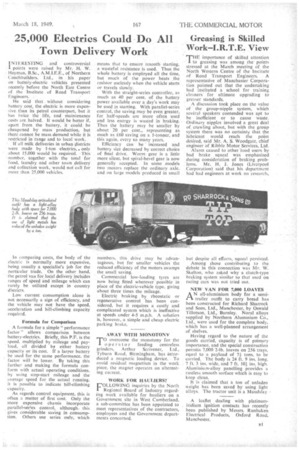25,000 Eleetries Could Do All Town Delivery Work
Page 9

If you've noticed an error in this article please click here to report it so we can fix it.
INTERESTING and controversial I points were raised by Mr. H. W. Heyman, B.Sc., A.M.I.E.E., of Northern Coachbuilders, Ltd., in his paper on batteky-electric vehicles presented recently before the North East Centre of the Institute of Road Transport Engineers.
He said that without considering battery cost, the electric is more expensive than its petrol counterpart, but it has twice the life, and maintenance costs are halved. It would be better if, apart from the battery, it could, be cheapened by mass produCtion, but there cannot be mass demand while it is restricted in range and to local work.
If all milk deliveries in urban districts were made by 1-ton electrics,. only about 15,000 would be required. This number, together with the total for food, laundry and other town delivery and collection work, would not call for more than 25,000 vehicles.
In comparing costs, the body of the electric is normally more expensive, being usually a specialist's job for the particular trade. On the other hand, the petrol van for local delivery includes ranges of Speed and *mileage which can rarely be utilized except in country districts.
Low current consumption alone is not necessarily a sign of efficiency, and the vehicle may not have the speed, acceleration and hill-climbing capacity required.
Formula for Comparison
A formula for a simple "performance factor" allows Comparison between battery-electrics. Briefly, this P.F. is the speed. multiplied by mileage and payload, all divided by either battery capacity or its cost. If a larrer battery be used for the same performance, the factor will be lower. By taking this further and making the formula conform with actual operating conditions, by using stop-start mileage and the average speed for the actual running, it is possible to indicate hill-climbing capacity.
As regards control equipment, this is often a matter of first cost. Only the more expensive chassis incorporate . parallel-series control, althoughthis gives considerable saving in consumption. Others use series only, which means that to ensure smooth starting, a wasteful resistance is used. Thus the whole battery is employed all the time, but much of the power heats the resistor uselessly when the vehicle starts or travels slowly.
• With the straight-series controller, as much as 40 per cent, of the battery power available over a day's work may be used in starting. With parallel-series control, the saving may be even greater, for half-speeds are more often Used and less energy is wasted in braking. Thus the battery may be smaller by about 20 per cent., representing as much as £60 saving on 'a 1-tonner, and this again, every so many yearS.
Efficiency can *be increased and battery size decreased by correct choice of final drive. Worm gear is a little more silent, but spiral-bevel gear is now generally accepted. In some models two motors replace the ordinary axle, and on large models produced in small
numbers, this drive may he advantageous, but for smaller vehicles the reduced efficiency of the motors swamps the small saving.
Commercial low-loading tyres are now being fitted wherever possible in place of the electric-vehicle type, giving about three times the mileage.
Electric braking by rheostatic or regenerative control has been considered, but it requires a costly and complicated system which is ineffective at speeds under 4-5 m.p.h. A solution is, howevei, a simple and cheap electric parking brake.


























